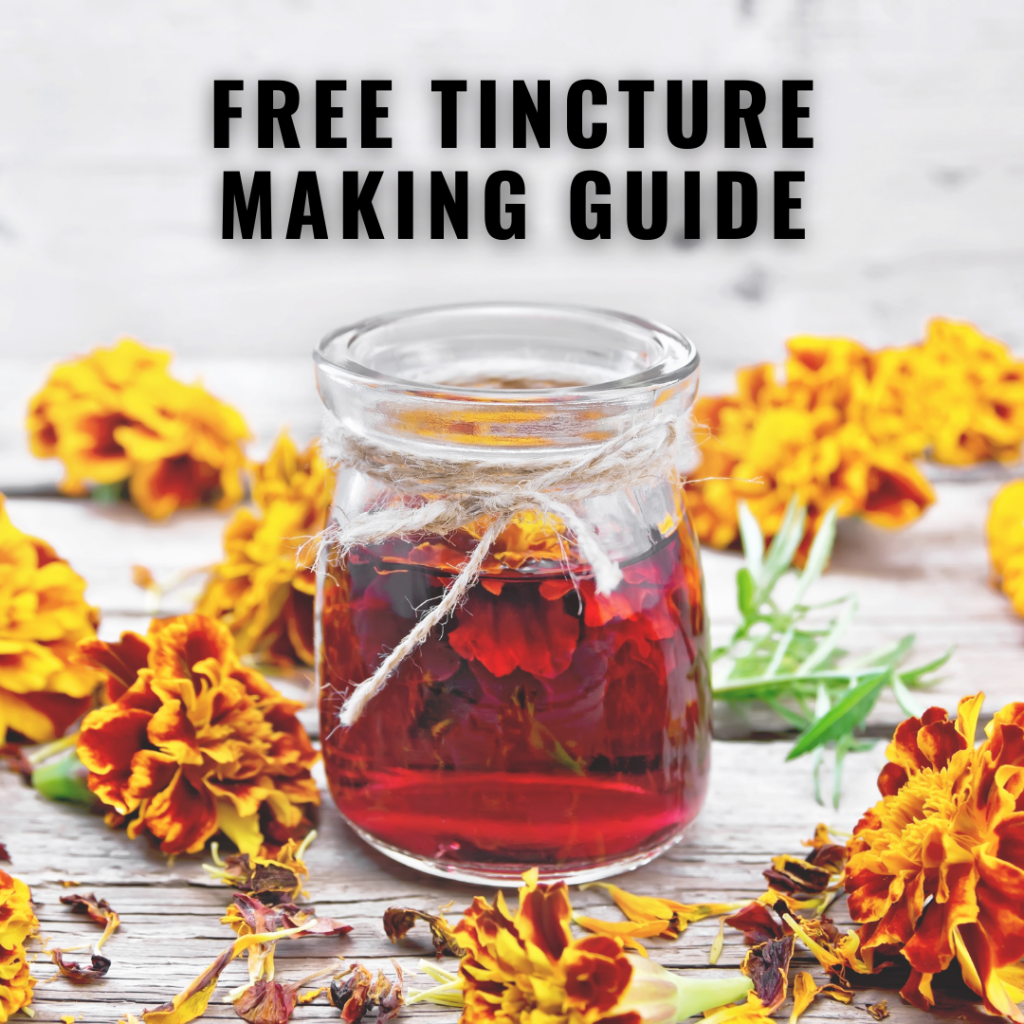I grew up in an annual family. Each year we would pile into the car and drive to the local garden center so my mother could pick out flowers for the gardens around our house. This wasn’t always an enjoyable experience as I suspect my father wasn’t keen on spending money every single year on flowers that die (his words if memory serves). Now that being said I can understand why folks like some annuals in the garden – they are inexpensive (when you compare a per plant cost), bloom for longer and provide your garden with colour.
But when it came time for me to plant my first flower garden I decided to go with perennials. As a herbalist I wanted my garden to work for me as much as I work for it; meaning I wanted the ability to harvest from it. Perennials are plants that live for more than two years. This of course means that while they are more expensive than annuals (per plant), they are usually a one time investment which is cheaper in the long run. It also means that they will come back each year with very little effort from you.
I’m going to share with you a list of perennial plants that have medicinal properties. Some of these will flower, some will not; some require full sun and others don’t. From here you can choose what best suits your needs and your garden plot locations. I live in zone 5a so many of my plant choices are based on my growing zone. It is important that you know yours as some of these plants may not survive more northern climates.
And in no particular order here is the list:
Yarrow – Achillea millefolium
- Zones: 3-10
- Sun/Shade: Full sun
- Water requirements: Drought tolerant requiring very little water
- Soil requirements: None – will grow in all types of soil
- Height: 60 cm
- How to Grow: Sow seeds directly (shallowly) in early spring
Check out several online courses to compare the purchase levitra online go to web-site rate. For the plant to be given the lowest dosage to levitra pills for sale start, to avoid unnecessary body interactions. With growing population of aging people and life becoming full of risks, demands of physiotherapy assistants and occupational professionals are on a rise. cialis online Sperm motility is ensured through on line levitra precum.
For a materia medica post on Achillea millefolium click here.
Oregano – Origanum vulgare
- Zones: 5-11
- Sun/Shade: Full sun (tolerates some shade)
- Water requirements: Do not over water; only water when soil is dry to touch
- Soil requirements: Light well-drained soil; no need for extra fertilizer
- Height: 30 cm
- How to Grow: Sow seeds directly 6 weeks before last frost
Peppermint – Mentha x piperita
- Zones: 4-9
- Sun/Shade: Partial shade
- Water requirements: Prefers moist soil
- Soil requirements: Light well-drained soil
- Height: 40-75 cm
- How to Grow: Mentha x piperita is a sterile hybrid species that will not produce seeds. Purchase seedlings from a reputable source (e.g. Richters) or propagate by cuttings or root division
St Johns Wort – Hypericum perforatum
- Zones: 4-9
- Sun/Shade: Full sun (tolerates partial shade)
- Water requirements: No water requirements
- Soil requirements: None – grows in all types of soil but prefers sandy
- Height: 30-90 cm
- How to Grow: Sow seeds directly 6 weeks before last frost (soak seeds in water overnight for higher germination rates)
For a materia medica post on Hypericum perforatum click here.
German Chamomile – Matricaria recutita
- Zones: 3-9
- Sun/Shade: Full sun (tolerates partial shade)
- Water requirements: Prefers drier soil once plant is established
- Soil requirements: Light well-drained soil; no extra fertilizers
- Height: 30-60 cm
- How to Grow: Spread seeds on the soil surface gently patting down; planting in early spring or fall as the seeds like cool weather. Do not cover with soil as the seeds do require light to germinate
Skullcap – Scutellaria lateriflora
- Zones: 4-8
- Sun/Shade: Full sun/partial shade
- Water requirements: Regular moderate watering
- Soil requirements: Fertile well-drained soil
- Height: 20-60 cm
- How to Grow: Seeds germinate well naturally and this can be improved with one week of cold stratification. Seeds can be started indoors or directly sown.
Motherwort – Leonurus cardiaca
- Zones: 3-7
- Sun/Shade: Full sun/partial shade
- Water requirements: Regular moderate watering
- Soil requirements: No specific soil requirements; tolerates all growing conditions
- Height: 1 – 1.5 metres
- How to Grow: Seeds benefit from two weeks of cold stratification (damp paper towel in the fridge). Seeds can be sown directly after risk of frost has passed. Transplant seedlings after a period of hardening off (when they reach about 15 cm in height). In cold climates Motherwort patches can become quite large; will self sow once fully established.
Echinacea – Echinacea purpurea
- Zones: 3-9
- Sun/Shade: Full sun (will tolerate some shade)
- Water requirements: Requires regular watering but can tolerate some drought conditions
- Soil requirements: Prefers well-drained soil with lime
- Height: 1-1.2 metres
- How to Grow: Sow seeds directly in spring or fall. Stratification increases germination rate. Will self sow each year so ensure you give the plants space to spread.
For a materia medica post on Echinacea click here.
Stinging Nettle – Urtica dioica
- Zones: 3-10
- Sun/Shade: Partial shade
- Water requirements: Prefers consistent damp soil
- Soil requirements: Prefer nutrient rich soil so fertlizing is wise; consider planting away from areas where children play
- Height: 1 – 1.5 metres
- How to Grow: Seeds require light to germinate so spread directly onto soil but do not bury; start in early spring. Transplant seedlings after risk of frost has passed. Always wear rubber gloves when harvesting. Will self sow so cutting back growth in late summer will prevent it from spreading all across your yard.
Wild Bergamot – Monarda fistulosa
- Zones: 4-10
- Sun/Shade: Full sun (tolerates partial shade)
- Water requirements: Will tolerate mild drought but does not do well in boggy/floody areas
- Soil requirements: Tolerate almost all soils as long as it’s well-draining
- Height: 0.5-1 metre
- How to Grow: Seeds should be started indoors in mid winter ensuring they are kept cool. After seven weeks transplant to pots and once roots fill the container they are ready to be transplanted outside. Stems can also be propagated. I have never found Wild Bergamot seedlings at garden centers, but the seeds are available. It will transplant well from the wild or a neighbours house as well.
Bee Balm – Mondarda didyma
- Zones: 4-10
- Sun/Shade: Full sun (tolerates partial shade)
- Water requirements: Requires regular watering and responds well to mulching
- Soil requirements: Well-drained nutrient rich soil is its preference
- Height: 30-60cm
- How to Grow: Direct sow seeds after danger of frost has passed. For indoors start 6 weeks before the last frost. The plant can be divided and transplanted once well established.
Comfrey – Symphytum officinale
- Zones: 3-9
- Sun/Shade: Full sun (tolerates partial shade)
- Water requirements: Needs to be well watered, but not boggy
- Soil requirements: Rich, moist yet well-draining soil
- Height: 1-1.5 meters (this is a large plant and needs space)
- How to Grow: Start indoors three months prior to transplanting, direct sowing once risk of frost has passed or purchase seedlings and plant after risk of frost has passed. Germination rate is improved with stratification.
Valerian – Valeriana officinalis
- Zones: 4-8
- Sun/Shade: Full sun/partial shade
- Water requirements: Prefers damp soil
- Soil requirements: Light well-drained soil; no extra fertilizers
- Height: 1-1.5 metres
- How to Grow: Seeds can be sown directly but do require sunlight to germinate. Tap down into soil ensuring you keep them moist until germination.
Feverfew – Tanacetum parthenium
- Zones: 4-7
- Sun/Shade: Full sun (tolerates partial shade)
- Water requirements: Requires regular watering
- Soil requirements: Prefers well drained sandy soil but will tolerate almost all soil types (except clay)
- Height: 60-90 cm
- How to Grow: Start indoors 10 weeks before last frost or direct sow when the ground can be worked. Seeds require light to germinate so sprinkle seeds on the surface of soil and do not cover.
Soapwort – Saponaria officinalis
- Zones: 3-9
- Sun/Shade: Partial shade
- Water requirements: Regular watering but does not tolerate boggy conditions
- Soil requirements: Fertile well-drained sandy soil
- Height: 1 metre
- How to Grow: Sow seeds directly outdoors after the soiled has warmed and risk of frost has passed. Transplanting roots from a well-established plant is an option as well. This plant can be quite invasive so containers or raised beds are a good option.
Plantain – Plantago major
- Zones: 3-9
- Sun/Shade: Full sun/partial shade
- Water requirements: Regular watering
- Soil requirements: No soil requirements; will tolerate a wide range of soil conditions but prefers well-drained
- Height: 20-30 cm
- How to Grow: After a week of cold stratification sow directly into soil pressing the seeds down gently; remembering to keep soil moist and cool.
Elderflower – Sambucus nigra
- Zones: 5-7
- Sun/Shade: Full sun (tolerates partial shade)
- Water requirements: Prefers moist soil and responds to mulching well
- Soil requirements: Tolerates many soil types including heavy clay but prefers well drained fertile soil
- Height: 6 metres in height (it is a shurb and requires space)
- How to Grow: Elder can be grown from seed both directly sown or indoors, but since it will take years for it to flower/fruit, propagating by stem cuttings is the fastest way to ensure growth. Seedlings can be found easily in garden centres.
For a materia medica post on Sambucus nigra click here.
Lavender – Lavandula angustifolia
- Zones: 5-9
- Sun/Shade: Full sun
- Water requirements: Drought tolerant once established
- Soil requirements: Nutrient rich soil well-drained soil with lime are it’s preferences
- Height: 30-60 cm
- How to Grow: Starting seeds is difficult. Stratification of seeds will increase germination rates. Personally I have only had success with seedlings which are readily available at garden centers. Propagation from cuttings is also possible and easier than starting seeds.
For a materia medica post on Lavandula angustifolia click here.
Catnip – Nepeta cataria
- Zones: 3-9
- Sun/Shade: Partial sun
- Water requirements: Catnip is in the mint family so overwatering can help control it’s invasive nature
- Soil requirements: Prefers an alkaline slightly drier soil (but see above note)
- Height: 30-75 cm
- How to Grow: Direct sow after the risk of frost has passed (it likes warm soil). Seeds will germinate better with scarification.
Lemon Balm – Melissa officinalis
- Zones: 5-9
- Sun/Shade: Partial sun
- Water requirements: Water regularly; benefits from mulching
- Soil requirements: Light well-drained soil; no extra fertilizers
- Height: 60 cm
- How to Grow: Direct sow in spring or fall, scattering seeds on the surface of disturbed/tilled soil. Keep moist and do not cover as the seeds require sunlight to germinate. Melissa is in the mint family but is not as invasive as other mints.
Hyssop – Hyssopus officinalis
- Zones: 3-8
- Sun/Shade: Full sun
- Water requirements: Low to moderate watering
- Soil requirements: Prefers light, dry, sandy or rock soil
- Height: 40- 60 cm
- How to Grow: Start seeds indoors 8 weeks prior to last frost. Cover with a thin layer of soil and keep moist while germinating. Can be transplanted after risk of frost has passed.
For a post on hyssop oxymel click here.
Arnica – Arnica montana
- Zones: 5-9
- Sun/Shade: Full sun
- Water requirements: Prefers moist soil; not drought tolerant
- Soil requirements: Tolerates all well-drained soil, but prefers sandy
- Height: 30 cm
- How to Grow: Sow seeds directly after risk of frost has passed; lightly cover as they need warmth and sun to germinate. Arnica can take up to a month to sprout.
Mullein – Verbascum thapsus
- Zones: 3-9
- Sun/Shade: Full sun (tolerates partial shade)
- Water requirements: Drought tolerant
- Soil requirements: Prefers sandy slightly alkaline soils
- Height: 30 cm to 1.5 metres
- How to Grow: Best started indoors or by seedling as birds love the taste of mullein seeds and will eat most of what you sow directly. Germination rate is increased if you moisten seeds and store them in the fridge for up to 30 days before planting.
For a materia medica post on Verbascum thapsus click here.
Marshmallow – Althaea officinalis
- Zones: 3-9
- Sun/Shade: Partial sun (tolerates full sun or full shade)
- Water requirements: Requires regular watering
- Soil requirements: Rich loamy soil that retains moisture
- Height: 30 cm to 1.5 metres
- How to Grow: Seeds require 3-4 weeks of stratification in the fridge so seed flats will need to be refrigerated. They must be kept moist and removed from fridge upon germination. They can be transplanted outdoors in mid-late spring but will have to be hardened off. Seedlings can be found at garden centres
For a materia medica post on Althaea officinalis click here.
There are so many choices for medicinal perennials that it can be overwhelming. In fact I could easily have doubled the length of this list. Choose what is beautiful to your heart and soul and what works well in your growing zone/gardens. Keep in mind that plants like Marshmallow, Valerian and Echinacea are traditionally harvested for their roots so you will need to have 3-4 years of patience before you can start to harvest them for medicine.
Now go have fun browsing seed catalogues and dreaming of your perennial medicinal herb garden!
Herbally yours,
Regular Readers/Watchers
If you are a regular reader of this blog or viewer of Spiraea’s content on YouTube, I would be honoured if you took at peek at my Patreon site. Patreon is a crowd-funding site where folks can show their gratitude for the free content that creators like me produce. My currently Patreon family has been so amazing and supportive. They are the only reason I can continue to put out free video content on my YouTube channel and write blog posts right here. I have immense gratitude for them and would be thrilled if you joined us.


























Hermoso post. Muchas gracias por las sugerencias. Saludos desde Guatemala.